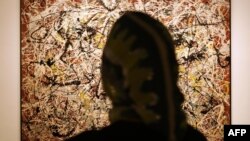You may find it surprising to learn that the most valuable work by the American artist Jackson Pollock, the commanding figure of the Abstract Expressionist movement, is owned by -- wait for it -- Iran.
"Mural on Indian Red Ground," painted in 1950, was purchased by the wife of the shah of Iran and was nationalized after the overthrow of the shah in 1979.
What may be even more surprising is that Iran has agreed to lend the painting -- valued at $250 million -- to Japan for a major exhibition of Pollock's work to mark the centenary of his birth.
The exhibition at the Tokyo National Museum of Modern Art marks the first time that the painting has left Iran in 35 years and is the first major exhibition of Pollock's work ever held in Japan.
Also on show are "No. 7, 1950" and "No. 11, 1949," on loan from the Museum of Modern Art in New York and Indiana University, as well as some 70 others borrowed from the United States and Europe.
As C.B. Liddell notes in an article about the exhibit in Japan's English-language "Metropolis" magazine:
As the French news agency AFP reports, "Mural on Indian Red Ground" is normally kept out of view by Iran's Museum of Contemporary Art, alongside other allegedly "decadent" artworks that are not officially approved by Iran's Islamic regime.
But it does see the light of day on occasion, perhaps most recently in 2005, as part of an exhibition on modern art at Tehran's Museum of Contemporary Art. In that show, artworks from the 19th and 20th centuries, including some 170 paintings and 15 sculptures purchased prior to the 1979 Islamic Revolution, were put on public display for two months.
-- Grant Podelco and Robert Coalson
"Mural on Indian Red Ground," painted in 1950, was purchased by the wife of the shah of Iran and was nationalized after the overthrow of the shah in 1979.
What may be even more surprising is that Iran has agreed to lend the painting -- valued at $250 million -- to Japan for a major exhibition of Pollock's work to mark the centenary of his birth.
The exhibition at the Tokyo National Museum of Modern Art marks the first time that the painting has left Iran in 35 years and is the first major exhibition of Pollock's work ever held in Japan.
Also on show are "No. 7, 1950" and "No. 11, 1949," on loan from the Museum of Modern Art in New York and Indiana University, as well as some 70 others borrowed from the United States and Europe.
As C.B. Liddell notes in an article about the exhibit in Japan's English-language "Metropolis" magazine:
The astronomical values placed on Pollock’s works may seem a little baffling, given that almost anyone with a few cans of paint and a bad attitude could create them, but their importance is partly historical. During the Cold War they served as ideological symbols of the “total freedom” available in the West. The value also reflects Pollock’s celebrity status as the ultimate artistic “hepcat,” and his untimely death in 1956 at the age of 44.
As the French news agency AFP reports, "Mural on Indian Red Ground" is normally kept out of view by Iran's Museum of Contemporary Art, alongside other allegedly "decadent" artworks that are not officially approved by Iran's Islamic regime.
But it does see the light of day on occasion, perhaps most recently in 2005, as part of an exhibition on modern art at Tehran's Museum of Contemporary Art. In that show, artworks from the 19th and 20th centuries, including some 170 paintings and 15 sculptures purchased prior to the 1979 Islamic Revolution, were put on public display for two months.
-- Grant Podelco and Robert Coalson




